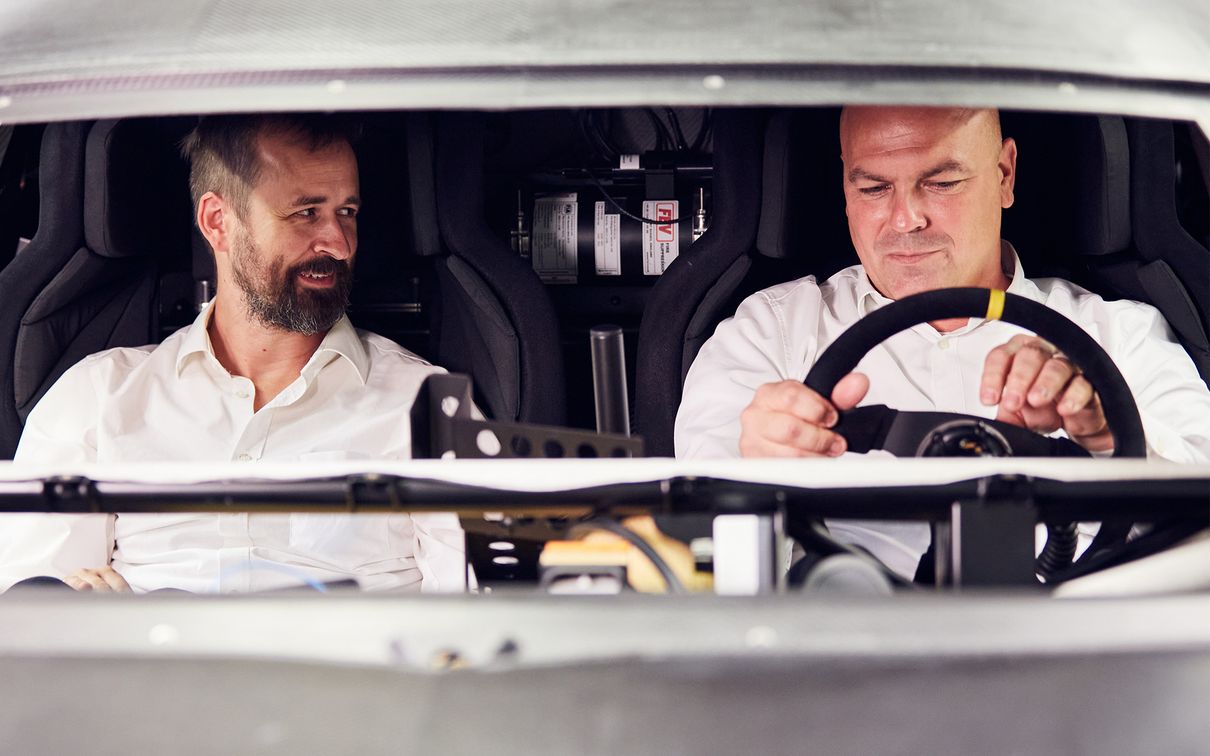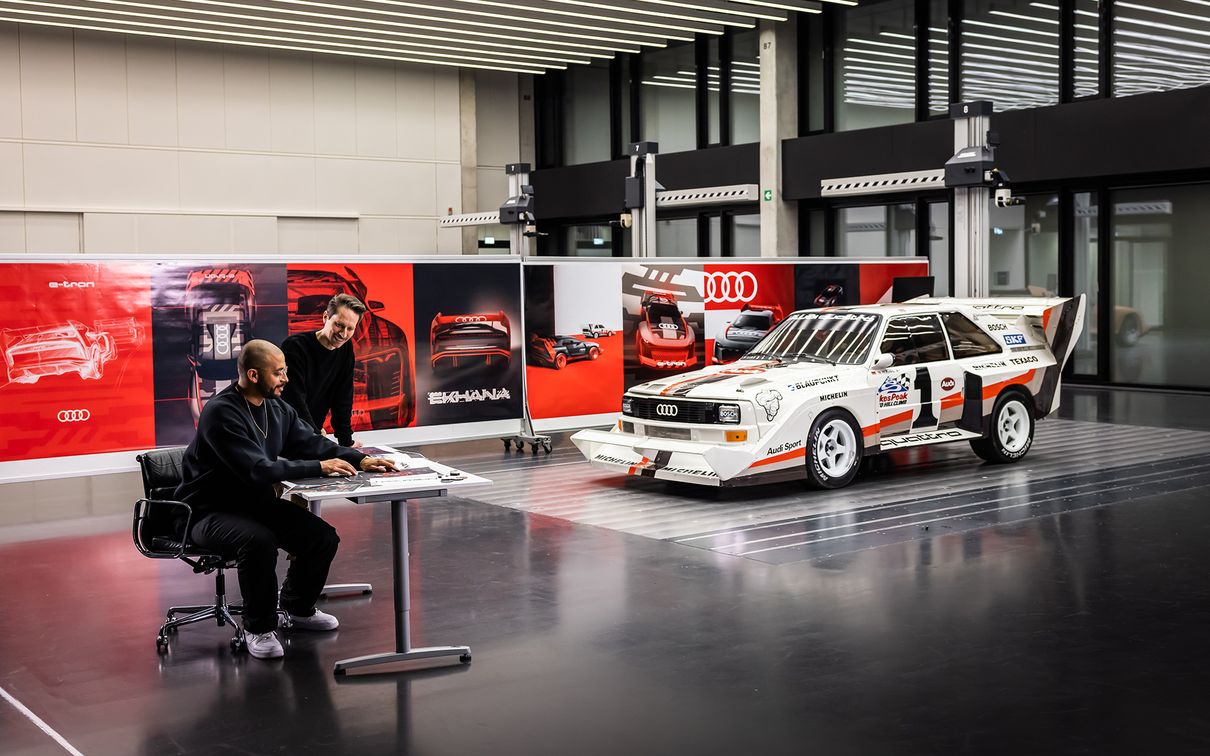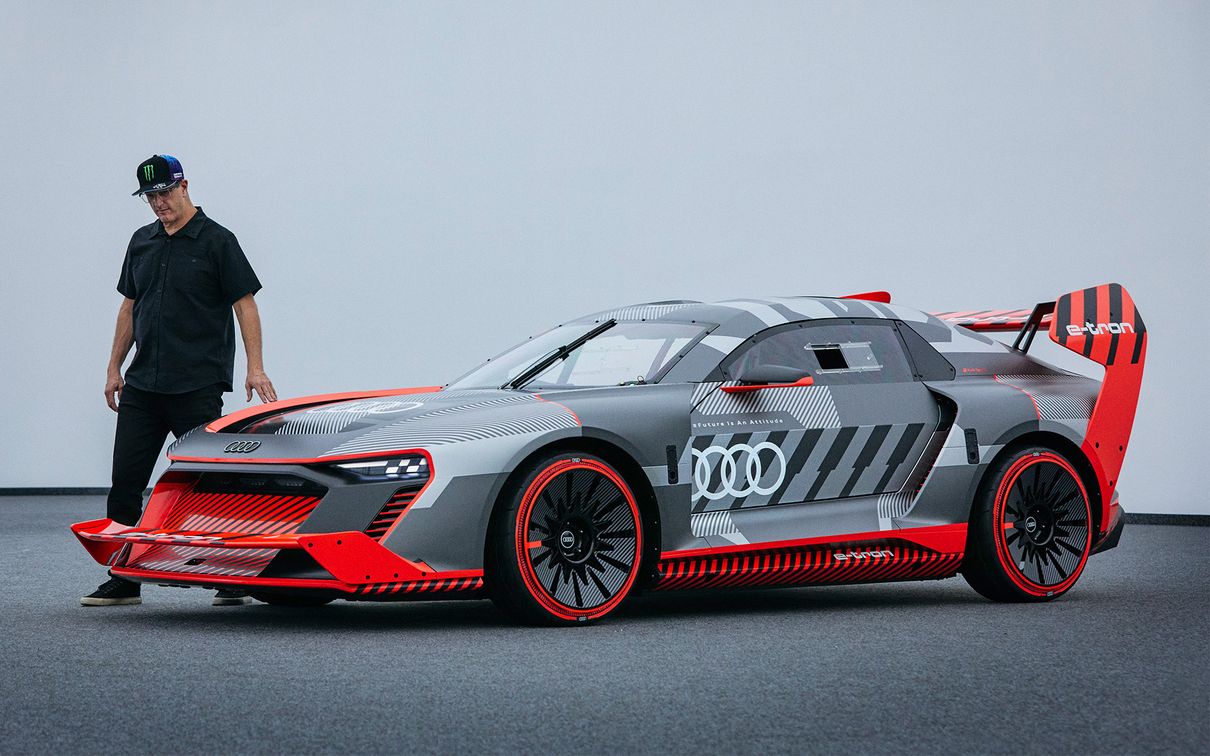The retro-futuristic unique car
¹The vehicle mentioned and shown is intended for professional use on closed circuits only and is not available as a production model.
¹The vehicle mentioned and shown is intended for professional use on closed circuits only and is not available as a production model.

Stefan Murrweiss crosses his hands behind his head in his office at the Neckarsulm plant. How did it all start with the Hoonitron? The 50-year-old, who has been working at Audi for over 20 years, takes a deep breath – and begins to tell the story: ‘They said: we need a car. For Ken Block. It should be fully electric, able to drift and ready in a few months.’ They asked: ‘Can you build that?’ Soon after, another aspect was added: ‘The vehicle was to be a tribute to the legendary Audi Sport quattro S1 from the 1980s.’ Building a machine for the uncrowned king of drifting cars – Ken Block – which should conjure up images of a rally legend and quattro veteran: that was the task for Stefan Murrweiss, and its name was to be the Audi S1 e-tron quattro Hoonitron¹. ‘I was aware of Ken Block and his drifting videos, but up to that point I had never thought about what such a vehicle had to be able to do,’ admits Murrweiss, who is usually the vehicle developer of Audi Sport series models. Electrification and the resemblance to the Sport quattro were the first cornerstones, providing rough proportions and making all-wheel drive a necessity. ‘That’s where we started out and put together a team.’ That was in March 2021.
¹The vehicle mentioned and shown is intended for professional use on closed circuits only and is not available as a production model.
¹The vehicle mentioned and shown is intended for professional use on closed circuits only and is not available as a production model.
“It was about building a prototype that shows the extremes of what e-technology can do.”

¹The vehicle mentioned and shown is intended for professional use on closed circuits only and is not available as a production model.
¹The vehicle mentioned and shown is intended for professional use on closed circuits only and is not available as a production model.
One member of this team, which consisted of colleagues from a wide variety of departments within AUDI AG, was Bastian Rosenauer. The 41-year-old is responsible for the concept development of series models at Audi Sport, as part of the team led by Stefan Murrweiss. ‘I immediately thought to myself: this is my ideal project,’ says Rosenauer. ‘I spent eight years implementing shell constructions for high-performance projects. And I have coordinated prototypes in customer racing, supervised vehicles during testing and accompanied races.’ His expertise and network quickly led to him playing a central role in the creation of the Hoonitron. ‘In the end, I was involved in everything from the concept development to the vehicle implementation. It was a unique opportunity.’ Over the development and construction period, Rosenauer practically moved his workplace to the workshop below his actual office. Although, as it turned out, the pandemic meant that the car was actually created in various living rooms and home offices, or in the kitchens of the team members. ‘We had a video call once a week and laid out everything that needed to be discussed on the digital table,’ Murrweiss recalls. ‘We only ever went into depth in small groups. That made us very efficient.’
“I immediately thought to myself: this is my ideal project.”

And the team needed to be efficient. Just under eight months after the start of the project, in November 2021, the vehicle was to be ready for use. ‘It was immediately clear that we could not newly develop everything under these conditions,’ says Rosenauer. But it turned out that it was not possible to simply use an existing vehicle chassis as a base, which would have saved a lot of time. The specifications for the wheelbase and proportions, for example, were too demanding. ‘The best solution for us was to design a new shell, tailored to the specifications of the exterior design, to suit the existing components such as the chassis, battery and, last but not least, the ideas of Ken Block,’ explains Rosenauer. ‘Whenever possible, we wanted to reintegrate technology that we had already tested into this new application environment.’ Because, as Rosenauer explains, they wanted to design a robust, functional vehicle, without ‘bells and whistles’. It was never about building an exhibit for event trade fairs, but rather a prototype that shows the extremes of what e-technology can do. The aim was that in just ten weeks the design process should be completed and the construction ready. ‘We had to plan in the rest of the time to procure parts, assemble them and carry out the necessary tests,’ says Murrweiss regarding the schedule.
“The proportions are similar to those of the legendary Audi Sport quattro S1. But we made them wider and flatter.”

¹The vehicle mentioned and shown is intended for professional use on closed circuits only and is not available as a production model.
¹The vehicle mentioned and shown is intended for professional use on closed circuits only and is not available as a production model.
Sascha Heyde, exterior designer at AUDI AG, played a key role in driving the design process forward. ‘When you are faced with such a task,’ the 44-year-old says, ‘the first reaction is pure enthusiasm.’ Various drafts were developed in different teams and coordinated with Marc Lichte, Audi’s chief designer. ‘Marc Lichte wanted to go in a very specific direction. Not a redesign of the legendary Audi Sport quattro S1, but capturing its soul,’ recalls Heyde. Retro-futuristic was the key term. In the end, it was Sascha Heyde’s design that set the course. One sticking point, including in the discussion with Murrweiss and Rosenauer, was the low vehicle height. ‘That’s exactly what is so futuristic about the car,’ explains Heyde. ‘The proportions are similar to those of the Audi Sport quattro S1. Features such as the flared wheel arches, the so-called quattro blisters, the front and rear spoilers also appear on the Hoonitron. But we scaled everything and made it wider and also flatter. The aim was for the design to look like a UFO.’ In just four weeks, the exterior design of the Audi S1 Hoonitron¹ was approved. ‘Of course you want more time,’ says Heyde, ‘as a designer, you still want to optimise, take a fresh look at some surfaces. But this was not about winning a beauty contest, it was about a vehicle designed to go to extremes.’ But if he had had a free hand, it would be even flatter, wider and would have much larger wheels, he admits with a grin.
¹The vehicle mentioned and shown is intended for professional use on closed circuits only and is not available as a production model.
¹The vehicle mentioned and shown is intended for professional use on closed circuits only and is not available as a production model.
“You have to figure out how to achieve the greatest visual impact without masking the significance of the component.”

¹The vehicle mentioned and shown is intended for professional use on closed circuits only and is not available as a production model.
¹The vehicle mentioned and shown is intended for professional use on closed circuits only and is not available as a production model.
The fact that the Hoonitron sits on comparatively small, compared to current concept cars, for example, 18-inch wheels has to do with a requirement from Ken Block. That they don’t seem so small at first glance, has to do with Marco dos Santos. ‘We were looking for a way to make the wheels appear bigger. Covers on the rims, with a red outer colour ring, achieve exactly that amazing effect.’ Marco dos Santos had already had one or two surprises up his sleeve at Audi. As part of the Audi Design Branding team, the 34-year-old designs vehicle wraps. ‘We develop visual languages that start on the product, but then also form a graphical bracket in communication, for example.’ Dos Santos did not see the call from Sacha Heyde, who wanted to bring him into the design team, coming. ‘Honestly, I thought, alright, that sounds exciting, but also kind of unrealistic.’ He and Sascha Heyde then talked a lot about the importance of design, about the connection between past and future. ‘We had to decide which elements of the vehicle formed its identity and then look at how we could communicate them in the overall context of e-tron.’ The striking neon-red front and rear spoilers are firmly linked to Audi e-tron history, as can currently be seen in the Dakar Rally car or – in a brand-new development – in the Formula 1 prototype. ‘However, there is often more than one way to achieve the desired effect. You have to figure out how to achieve the greatest visual impact without masking the significance of the component.’ But in the case of the Hoonitron, the design was allowed to be a bit more aggressive and louder, says dos Santos. ‘In this way, we visually connected the rear spoiler to the front spoiler via the side sill,’ explains dos Santos. ‘The whole vehicle radiates power.’ No matter if you are standing directly in front of it or further back, he adds.
And close up, there is agreement in both Neckarsulm and Ingolstadt that the Audi S1 e-tron quattro Hoonitron¹, which was developed, designed and built in record time with a lot of passion and expertise across various disciplines, is perfect. Stefan Murrweiss even slipped into the role of Ken Block in the process. ‘But only because we are the same height. We had to precisely plan the necessary switches, levers and pedals in the cockpit and Ken Block couldn’t be with us at all times.’ Now, exactly two people can drive the car, he says, tongue in cheek: ‘Ken Block and I.’
¹The vehicle mentioned and shown is intended for professional use on closed circuits only and is not available as a production model.
¹The vehicle mentioned and shown is intended for professional use on closed circuits only and is not available as a production model.






